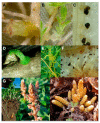Management of Infection by Parasitic Weeds: A Review
- PMID: 32932904
- PMCID: PMC7570238
- DOI: 10.3390/plants9091184
Management of Infection by Parasitic Weeds: A Review
Abstract
Parasitic plants rely on neighboring host plants to complete their life cycle, forming vascular connections through which they withdraw needed nutritive resources. In natural ecosystems, parasitic plants form one component of the plant community and parasitism contributes to overall community balance. In contrast, when parasitic plants become established in low biodiversified agroecosystems, their persistence causes tremendous yield losses rendering agricultural lands uncultivable. The control of parasitic weeds is challenging because there are few sources of crop resistance and it is difficult to apply controlling methods selective enough to kill the weeds without damaging the crop to which they are physically and biochemically attached. The management of parasitic weeds is also hindered by their high fecundity, dispersal efficiency, persistent seedbank, and rapid responses to changes in agricultural practices, which allow them to adapt to new hosts and manifest increased aggressiveness against new resistant cultivars. New understanding of the physiological and molecular mechanisms behind the processes of germination and haustorium development, and behind the crop resistant response, in addition to the discovery of new targets for herbicides and bioherbicides will guide researchers on the design of modern agricultural strategies for more effective, durable, and health compatible parasitic weed control.
Keywords: Cuscuta; Orobanche; Phelipanche; Striga; bioherbicides; crop resistance; germination; haustorium; sustainable control; virulence.
Conflict of interest statement
The authors declare no conflict of interest.
Figures







Similar articles
-
Induction of Haustorium Development by Sphaeropsidones in Radicles of the Parasitic Weeds Striga and Orobanche. A Structure-Activity Relationship Study.J Agric Food Chem. 2016 Jun 29;64(25):5188-96. doi: 10.1021/acs.jafc.6b01910. Epub 2016 Jun 16. J Agric Food Chem. 2016. PMID: 27267731
-
Crop diversification and parasitic weed abundance: a global meta-analysis.Sci Rep. 2022 Nov 12;12(1):19413. doi: 10.1038/s41598-022-24047-2. Sci Rep. 2022. PMID: 36371505 Free PMC article.
-
Using biotechnological approaches to develop crop resistance to root parasitic weeds.Planta. 2021 Apr 12;253(5):97. doi: 10.1007/s00425-021-03616-1. Planta. 2021. PMID: 33844068 Review.
-
Comparative secretome analysis of Striga and Cuscuta species identifies candidate virulence factors for two evolutionarily independent parasitic plant lineages.BMC Plant Biol. 2024 Apr 6;24(1):251. doi: 10.1186/s12870-024-04935-7. BMC Plant Biol. 2024. PMID: 38582844 Free PMC article.
-
The Effect of Virulence and Resistance Mechanisms on the Interactions between Parasitic Plants and Their Hosts.Int J Mol Sci. 2020 Nov 27;21(23):9013. doi: 10.3390/ijms21239013. Int J Mol Sci. 2020. PMID: 33260931 Free PMC article. Review.
Cited by
-
Effects of Benzoquinones on Radicles of Orobanche and Phelipanche Species.Plants (Basel). 2021 Apr 11;10(4):746. doi: 10.3390/plants10040746. Plants (Basel). 2021. PMID: 33920368 Free PMC article.
-
Characterization of Conyza bonariensis Allelochemicals against Broomrape Weeds.Molecules. 2022 Nov 1;27(21):7421. doi: 10.3390/molecules27217421. Molecules. 2022. PMID: 36364247 Free PMC article.
-
Search for Resistant Genotypes to Cuscuta campestris Infection in Two Legume Species, Vicia sativa and Vicia ervilia.Plants (Basel). 2021 Apr 9;10(4):738. doi: 10.3390/plants10040738. Plants (Basel). 2021. PMID: 33918953 Free PMC article.
-
Heat Stress and Plant-Biotic Interactions: Advances and Perspectives.Plants (Basel). 2024 Jul 23;13(15):2022. doi: 10.3390/plants13152022. Plants (Basel). 2024. PMID: 39124140 Free PMC article. Review.
-
Allelopathic Effect of Quercetin, a Flavonoid from Fagopyrum esculentum Roots in the Radicle Growth of Phelipanche ramosa: Quercetin Natural and Semisynthetic Analogues Were Used for a Structure-Activity Relationship Investigation.Plants (Basel). 2021 Mar 13;10(3):543. doi: 10.3390/plants10030543. Plants (Basel). 2021. PMID: 33805844 Free PMC article.
References
-
- Kuijt J. The Biology of Parasitic Plants. University of California Press; Berkeley, CA, USA: 1969.
-
- Parker C., Riches C.R. Parasitic Weeds of the World: Biology and Control. CAB International; Wallingford, UK: 1993.
-
- Nickrent D.L., Malécot V., Vidal-Russell R., Der J.P. A revised classification of Santalales. Taxon. 2010;59:538–558. doi: 10.1002/tax.592019. - DOI
-
- Heide-Jørgensen H.S. Introduction: The parasitic syndrome in Higher Plants. In: Joel D.M., Gressel J., Musselman L.J., editors. Parasitic Orobanchaceae. Springer; Berlin/Heidelberg, Germany: 2013. pp. 1–18.
Publication types
Grants and funding
LinkOut - more resources
Full Text Sources

